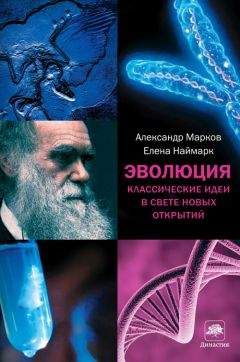Александр Марков - Эволюция. Классические идеи в свете новых открытий

Помощь проекту
Эволюция. Классические идеи в свете новых открытий читать книгу онлайн
Eldar A., Chary V. K., Xenopoulos P., et al. 2009. Partial penetrance facilitates developmental evolution in bacteria // Nature. V. 460. P. 510–514.
Elf J., Li G.-W., Xie X. S. 2007. Probing transcription factor dynamics at the single-molecule level in a living cell //Science. V. 316. P. 1191–1194.
Emerson B. C., Kolm N. 2005. Species diversity can drive speciation // Nature. V. 434. P. 1015–1017.
EppLey J. M., Tyson G. W., Getz W. M., Banfield J. F. 2007. Genetic exchange across a species boundary in the archaeal genus Ferroplasma // Genetics. V. 177 (1). P. 407–416.
Fay J. C., Benavides J. A. 2005. Evidence for domesticated and wild populations of Saccharomyces cerevisiae // PLoS Genetics. V. 1. P. e5.
Feil E. J., Maynard Smith J., Enright M. C., Spratt B. G. 2000. Estimating recombinational parameters in Streptococcus pneumoniae from multilocus sequence typing data // Genetics. V. 154. P. 1439–1450.
Fiegna F., Yu Y.-T. N., Kadam S. V., Velicer G. J. 2006. Evolution of an obligate social cheater to a superior cooperator // Nature. V. 441. P. 310–314.
Forbes A. A., Powell T. H. Q., Stelinski L. L., et al. 2009. Sequential sympatric speciation across trophic levels // Science. V. 323. P. 776–779.
Frankel N., Davis G. K., Vargas D., et al. 2010. Phenotypic robustness conferred by apparently redundant transcriptional enhancers // Nature. V. 466. P. 490–493.
Friedman М. 2008. The evolutionary origin of flatfish asymmetry // Nature. V. 454. P. 209–212.
Gibbs K. A., Urbanowski М. L., Greenberg E. P. 2008. Genetic determinants of self identity and social recognition in Bacteria // Science. V. 321. P. 256–259.
Gilad Y., Oshlack A., Smyth G. K., et al. 2006. Expression profiling in primates reveals a rapid evolution of human transcription factors // Nature. V. 440. P. 242–245.
Goddard М. R., Godfray H. C., Burt A. 2005. Sex increases the efficacy of natural selection in experimental yeast populations // Nature. V. 434. P. 636–640.
Goldberg E. E., Kohn J. R., Lande R., et al. 2010. Species selection maintains self-incompatibility // Science. V. 330. P. 493–495.
Grant P. R., Grant B. R. 2002. Unpredictable evolution in a 30-year study of Darwin’s finches // Science. V. 296. P. 707–711.
Gray J. C., Goddard М. R. 2012. Sex enhances adaptation by unlinking beneficial from detrimental mutations in experimental yeast populations // BMC Evolutionary biology. V. 12. P. 43.
Haag E. S. 2005. The evolution of nematode sex determination: C. elegans as a reference point for comparative biology, WormBook, ed. The C. elegans Research Community, WormBook, doi/10.1895/wormbook.1.120.1, http://www.wormbook.org/
Haldane J. B. S. 1933. The part played by recurrent mutation in evolution // Am. Nat. V. 67. P. 5–19.
Hamilton W. D., Axelrod R., Tanese R. 1990. Sexual reproduction as an adaptation to resist parasites (a review) // Proc. Nat. Acad. Sci. USA. V. 87. P. 3566–3573.
Harmon L. J., Matthews B., Des Roches S., et al. 2009. Evolutionary diversification in stickleback affects ecosystem functioning // Nature. V. 458. P. 11671170.
Hayden E. J., Ferrada E., Wagner A. 2011. Cryptic genetic variation promotes rapid evolutionary adaptation in an RNA enzyme // Nature. V. 474. P. 92–95.
Hillenmeyer М. E., Fung E., Wildenhain J., et al. 2008. The chemical genomic portrait of yeast: Uncovering a phenotype for all genes // Science. V. 320. P. 362–365.
Hittinger С. Т., Carroll S. B. 2007. Gene duplication and the adaptive evolution of a classic genetic switch // Nature. V. 449. P. 677–681.
Hofmann С. M., O’Quin K. E., Marshall N. J., et al. 2009. The eyes have it: Regulatory and structural changes both underlie cichlid visual pigment diversity // PLoS Biology. V. 7. P. e1000266.
Hong J. W., Hendrix D. A., Levine M. S. 2008. Shadow enhancers as a source of evolutionary novelty // Science. V. 321. P. 1314.
Hopkins R., Rausher M. D. 2012. Pollinator-mediated selection on flower color allele drives reinforcement // Science. V. 335. P. 1090–1092.
Horvath P., Barrangou R. 2010. CRISPR/Cas, the immune system of Bacteria and Archaea // Science. V. 327. P. 167–170.
Hoskin С. J., Higgie M. 2010. Speciation via species interactions: the divergence of mating traits within species // Ecology Letters. V. 13. P. 409–420.
Hunt D. E., David L. A., Gevers D., et al. 2008. Resource partitioning and sympatric differentiation among closely related bacterioplankton // Science. V. 320. P. 1081–1085.
Ishii Т., Hirota J., Mombaerts P. 2003. Combinatorial coexpression of neural and immune multigene families in mouse vomeronasal sensory neurons // Current Biology. V. 13. P. 394–400.
Jablonski D. 2008. Species selection: theory and data // Annual Review of Ecology, Evolution, and Systematics. V. 39. P. 501–524.
Jacobs G. H., Williams G. A., Cahill H., Nathans J. 2007. Emergence of novel color vision in mice engineered to express a human cone photopigment // Science. V. 315. P. 1723–1725.
Jeltsch A. 2003. Maintenance of species identity and controlling speciation of bacteria: a new function for restriction/modification systems? // Gene. V. 317. P. 13–16.
Kilias G., Alahiotis S. N., Pelecanos M. 1980. A multifactorialgenetic investigation of speciation theory using Drosophila melanogaster // Evolution. V. 34. P. 730–737.
Kishida Т. 2008. Pattern of the divergence of olfactory receptor genes during tetrapod evolution // PLoS ONE. V. 3. P. e2385.
Kondrashov A. S. 1994. Gradual origin of amphimixis by natural selection // Lectures on Mathematics in the Life Sciences. V. 25. P. 27–52.
Korchi A., Brossut R., Bouhin H., DeLachambre J. 1999. cDNA cloning of an adult male putative lipocalin specific to tergal gland aphrodisiac secretion in an insect (Leucophaea maderae) // FEBS Letters. V. 449. P. 125–128.
Korol A., Rashkovetsky E., Iliadi K., et al. 2000. Nonrandom mating in Drosophila melanogaster laboratory populations derived from closely adjacent ecologically contrasting slopes at ‘Evolution canyon’ // Proc. Nat. Acad. Sci. USA. V. 97. P. 12637-12642.
Koshiba-Takeuchi K., Mori A. D., Kaynak B. L., et al. 2009. Reptilian heart development and the molecular basis of cardiac chamber evolution // Nature. V. 461. P. 95–98.
Lang M., Murat S., Clark A. G., et al. 2012. Mutations in the neverland gene turned Drosophila pachea into an obligate specialist species // Science. V. 337. P. 1658–1661.
Lawrence D., Fiegna F., Behrends V, et al. 2012. Species interactions alter evolutionary responses to a novel environment // PLoS Biology. V. 10 (5). P. 1001330.
Legras J. L., Merdinoglu D., Cornuet J. M., Karst F. 2007. Bread, beer and wine: Saccharomyces cerevisiae diversity reflects human history // Mol. Ecol. V. 16. P. 2091–2102.
Leinders-Zufall T., Brennan P., Widmayer P., et al. 2004. MHC class I peptides as chemosensory signals in the vomeronasal organ // Science. V. 306. P. 1033–1037.
Leinonen T., Herczeg G., Cano J. M., Merilä J. 2011. Predation-imposed selection on threespine stickleback (Gasterosteus aculeatus) morphology: a test of the refuge use hypothesis // Evolution. V. 65. P. 2916–2926.
Lenormand T., Otto S. P. 2000. The evolution of recombination in a heterogeneous environment // Genetics. V. 156. P. 423–438.
Li C., Zhou A., Sang T. 2006. Rice domestication by reducing shattering // Science. V. 311. P. 1936–1939.
Li J., Browning S., Mahal S. P., et al. 2010. Darwinian evolution of prions in cell culture // Science. V. 327. P. 869–872.
Li X., Cassidy J. J., Reinke C. A., et al. 2009. A microRNA imparts robustness against environmental fluctuation during development // Cell. V. 137. P. 273–282.
Lieberman E., Michel J.-B., Jackson J., et al. 2007. Quantifying the evolutionary dynamics of language // Nature. V. 449. P. 723–716.
Lindblad-Toh K., Garber M., Zuk O., et al. 2011. A high-resolution map of human evolutionary constraint using 29 mammals // Nature. V. 478. P. 476–482.
Linnen С. R., Kingsley E. P., Jensen J. D., Hoekstra H. E. 2009. On the origin and spread of an adaptive allele in deer mice // Science. V. 325. P. 1095–1098.
Liu С., Fu X., Liu L., et al. 2011. Sequential establishment of stripe patterns in an expanding cell population // Science. V. 334. P. 238–241.
Lively С. M. 1996. Host-parasite coevolution and sex // Bioscience. V. 46. P. 107–114.
Lively С. M., Craddock С., Vrijenhoek R. С. 1990. Red Queen hypothesis supported by parasitism in sexual and clonal fish // Nature. V. 344. P. 864–866.
Lowry D. B., Willis J. H. 2010. A widespread chromosomal inversion polymorphism contributes to a major life-history transition, local adaptation, and reproductive isolation // PLoS Biology. V. 8. P. e1000500.
Lukhtanov V. A., Dinca V, Talavera G., Vila R. 2011. Unprecedented within-species chromosome number cline in the wood white butterfly Leptidea sinapis and its significance for karyotype evolution and speciation // BMC Evolutionary Biology. V. 11. P. 109.
Lukhtanov V. A., Kandul N. P., Plotkin J. B. 2005. Reinforcement of pre-zygotic isolation and karyotype evolution in Agrodiaetus butterflies // Nature. V. 436. P. 385–389.
Luo Z.-X., Chen P., Li G., Chen M. 2007. A new eutriconodont mammal and evolutionary development in early mammals // Nature. V. 446. P. 288–293.
Macke E., Magalhaes S., Bach F., Olivieri I. 2011. Experimental evolution of reduced sex ratio adjustment under local mate competition // Science. V.334. P. 1127–1129.
Maddison W. P., Midford P. E., Otto S. P. 2007. Estimating a binary character’s effect on speciation and extinction // Systematic Biology. V. 56. P. 701–710.
Majerus M. E. N., Mundy N. I. 2003. Mammalian melanism: natural selection in black and white // Trends in Genetics. V. 19. P. 585–588.
Majewski J., Zawadzki P., Pickerill P. et al. 2000. Barriers to genetic exchange between bacterial species: Streptococcus pneumoniae transformation // J. Bacteriol. V. 182. P. 1016–1023.
Mandel M. J., Wollenberg M. S., Stabb E. V, et al. 2009. A single regulatory gene is sufficient to alter bacterial host range // Nature. V. 458. P. 215–218.
Marchinko K. B. 2009. Predation’s role in repeated phenotypic and genetic divergence of armor in threespine stickleback // Evolution. V. 63. P. 127–138.
Margulis L., Sagan D. 1986. Origins of sex. New Haven: Yale University Press.
Markmann K., Giczey G., Parniske M. 2008. Functional adaptation of a plant receptor-kinase paved the way for the evolution of intracellular root symbioses with Bacteria // PLoS Biology. V. 6 (3). P. e68.
Markov A. V., Lazebny O. E., Goryacheva I. I., et al. 2009. Symbiotic bacteria affect mating choice in Drosophila melanogaster // Animal Behaviour. V.77. P. 1011–1017.
Marraffini L. A., Sontheimer E. J. 2010. Self versus non-self discrimination during CRISPR RNA-directed immunity // Nature. V. 463. P. 568–571.
Martin R. E., Marchetti R. V, Cowan A. I., et al. 2009. Chloroquine transport via the malaria parasite’s chloroquine resistance transporter // Science. V. 325. P. 1680–1682.
Matsumoto M., Straub R. E., Marenco S., et al. 2008. The evolutionary conserved G protein-coupled receptor SREB2/GPR85 influences brain size, behavior, and vulnerability to schizophrenia // Proc. Nat. Acad. Sci. USA. V. 105. P. 6133–6138.
Matute D. R., Butler I. A., Turissini D. A., Coyne J. A. 2010. A test of the snowball theory for the rate of evolution of hybrid incompatibilities // Science. V.329. P. 1518–1521.
Mayr E. 1942. Systematics and the origin of species. New York: Columbia University Press.
Mayer W. E., Schuster L. N., Bartelmes G., et al. 2011. Horizontal gene transfer of microbial cellulases into nematode genomes is associated with functional assimilation and gene turnover // BMC Evolutionary Biology. V. 11. P. 13.
Maynard Smith J. 1970. Natural selection and the concept of a protein space // Nature. V. 225. P. 563–564.
McGrath P. T., Xu Y., Ailion M., et al. 2011. Parallel evolution of domesticated Caenorhabditis species targets pheromone receptor genes // Nature. V. 477. P. 321–325.
Meng J., Wang Y., Li C. 2011. Transitional mammalian middle ear from a new Cretaceous Jehol eutriconodont // Nature. V. 472. P. 181–185.
Milinski M., Griffiths S., Wegner K. M., et al. 2005. Mate choice decisions of stickleback females predictably modified by MHC peptide ligands // Proc. Nat. Acad. Sci. USA. V. 102. P. 4414–4418.
Miller W. J., Ehrman L., Schneider D. 2010. Infectious speciation revisited: impact of symbiont-depletion on female fitness and mating behavior of Drosophila paulistorum // PLoS Pathogens. V. 6. P. e1001214.
Molina J., Sikorab М., Garud N., et al. 2011. Molecular evidence for a single evolutionary origin of domesticated rice // Proc. Nat. Acad. Sci. USA. V. 108. P. 8351–8356.
Moran N. A., Jarvik T. 2010. Lateral transfer of genes from fungi underlies carotenoid production in aphids // Science. V. 328. P. 624–627.
Morran L. T., Parmenter М. D., Phillips P. C. 2009. Mutation load and rapid adaptation favour outcrossing over self-fertilization // Nature. V. 462. P. 350352.























